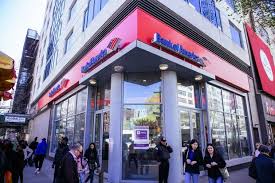As businesses hold back, U.S. consumers seen boosting big banks’ profits

Consumer lending is expected to propel profits for big U.S. banks when they unveil fourth-quarter results this week, though stress in corporate lending and uneven capital markets may cast a shadow over results.
Balances for individual borrowers keep reaching new records as the U.S. job market has stayed robust, prompting people to spend, and as interest rates have declined, prompting them to borrow — especially on credit cards.
Overall, U.S. consumer-loan balances at the 25 largest banks reached $ 1.19 trillion the last week of December, up 13% from a year earlier, according to Federal Reserve data. The biggest annual increase came from cards, where outstanding debt rose 16%.
The banks held another $ 1.46 trillion in residential mortgage loans.
(GRAPHIC: U.S. consumer leverage declined as incomes rose – here)
That spells good news for quarterly profits at JPMorgan Chase & Co (JPM.N) and Citigroup Inc (C.N), which have been working to grow their card businesses in recent years. The Fed’s decision to lower rates in 2019 boosted mortgage activity, which will help major home lenders like Wells Fargo & Co (WFC.N). Those three banks are scheduled to report results on Tuesday.
“The consumer-lending business is going to be very profitable for the banks,” RBC Capital Markets analyst Gerard Cassidy said in an interview.
Americans borrowing to buy cars and pay for vacations has been a mainstay for industry profits recently. Consumer strength has helped offset weakness in trading, underwriting or business-loan demand at various points, with bank executives cheering it as a sign that the U.S. economy is not on the brink of recession.
Analysts expect tepid business borrowing to have continued through the fourth quarter. Global trade disputes, political uncertainties and market fluctuations have left CEOs wary of seeking financing to buy competitors or invest in operations, they said.
However, those issues could take a back seat to the thriving U.S. consumer.
As Americans’ loan balances have climbed, their incomes have grown even faster. That debt is now about equal to disposable personal income after climbing to as much as one-third higher in 2007.
Analysts say they are also encouraged that banks appear to be lending more responsibly to consumers, partly due to new regulations. Consumer delinquency rates are low at 2.8%, compared with an average of 4.3% since 2003, according to Fed data. In the recession, the rate reached 8.2%.
However, analysts cautioned that credit mistakes often occur in the best of times and that it is hard to see them with the economy growing for the 11th straight year.
Higher real-estate values have allowed property owners to raise cash by selling or refinancing. As competition has heated up in cards, some borrowers have been transferring zero-interest balances from one bank to another for a small fee, without paying off the debt.
And although unemployment is at a 50-year low and wages are higher, there are still lots of consumers living paycheck-to-paycheck.
A Fed survey last year found 39% of Americans would have a hard time handling an unexpected $ 400 expense. People with credit cards generally are not at such risk, but still about 16% said they would put the expense on a card.
Fred Cannon, research director at Keefe, Bruyette & Woods, said a rise in unemployment in the next recession would expose bad loans. “There certainly could be some problems,” he said.
